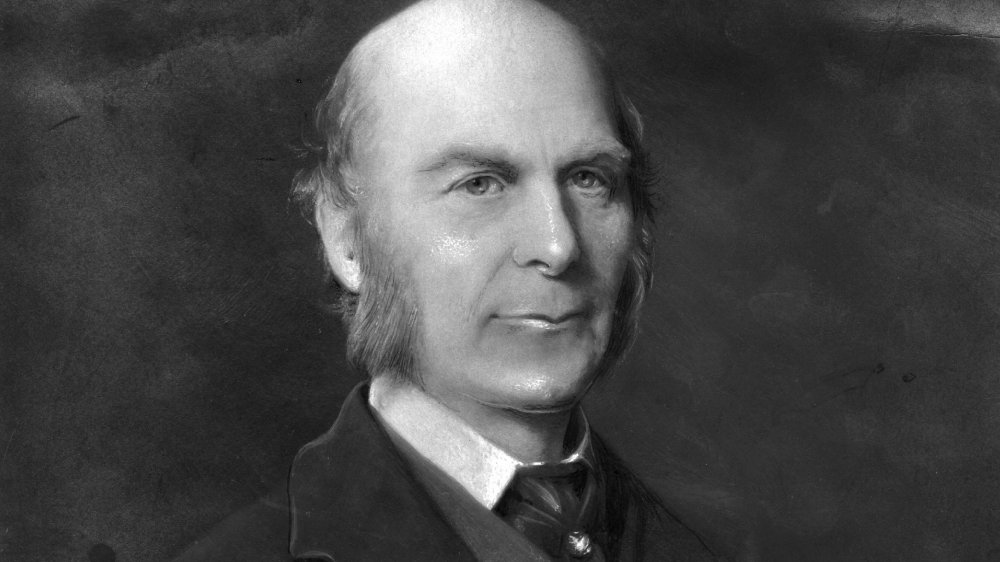The Messed Up History Of Eugenics
When history is taught in schools, there's a standard curriculum teachers adhere to. They generally stick to things like the American Revolution, a watered-down version of the Civil War, and maybe a bit of the World Wars.
But they usually don't touch on the truly dark stuff lurking in the corners of humanity's past. It's no wonder, really — kids aren't ready for that sort of thing, and they definitely wouldn't be sleeping at night.
Mankind's development of eugenics is definitely one of those things. At some point (and we'll talk about exactly what point), some guy who was definitely a white European man decided that natural selection wasn't doing so great when it came to keeping humanity made up of nothing but the best of the best. The cream of the crop, if you will. He decided something needed to be done about that, and because people can be pretty terrible, they ran with it. History classes don't teach kids about the times mankind tried to selectively breed out "undesirables," and that's a shame — because it's a part of history we need to remember.
History can blame Sir Francis Galton for the whole eugenics thing
It was Sir Francis Galton who came up with the term "eugenics" way back in 1883, and he coined it to describe a theory he had already spent years developing. The University of Virginia says he envisioned it meaning "well-born," and the whole root of the idea went back to his more famous cousin: Charles Darwin.
Most people are familiar with Darwin's work regarding evolution, and Galton was, too. He was captivated by the idea, and took it one step further. According to the Galton Institute, he published early texts on eugenics around 1864, and wrote about his discovery that there were a ton of "eminent men" who had family connections. Then, he suggested that success was genetic. He believed the most desirable characteristics of the human race — success, intelligence, and a fine, honest character — were passed down through the generations.
Galton suggested that if only the finest specimens married and reproduced, it would lead to the creation of a Utopian society. He "proved" his theory in a work called Hereditary genius, where he used the family trees of well-known men to illustrate how success seemed to run in the family. Not everyone agreed — some condemned it as obviously wrong, as it overlooked external influences. Galton wasn't dissuaded, and continued to promote his agenda of selective breeding. It wasn't long before it went completely off the rails.
The US considered locally-operated gas chambers for euthanasia
According to the University of Virginia, Galton's work focused on so-called "positive eugenics," which basically meant encouraging people with desirable characteristics to have more children. But it wasn't long before devotees developed a different kind — negative eugenics, which promoted the idea that the lower classes, the poor, and other "undesirables" needed to stop reproducing. From there, it was just one small step to suggesting there was a whole section of the population that needed to be removed from the gene pool entirely, and in 1911, a Carnegie-funded report explored exactly how that could be done.
The eighth item on the list (via The Jerusalem Post) was euthanasia. Specifically, it was suggested that undesirable people be sent to a "public locally operated gas chamber," and that's some serious Third Reich stuff right there. Other suggestions made in the report and by others around the same time were that physicians should let patients die if they were suffering from a hereditary malady or illness, that babies born "defective" should be denied medical attention and care until they simply died, or that they should be dosed with chloroform or cyanide.
That couldn't have happened ... right? It absolutely did. One hospital in Illinois started giving patients milk from cows infected with bovine tuberculosis, assuming that if they were genetically strong, they would survive. Around 30 to 40 percent of their patients died during this experiment.
So who, exactly, were the 'unfit' and 'undesirable?'
When talking about eugenics, it's important to also talk about exactly who was in the group of people most often deemed "undesirable." It's a long list.
According to PBS, the "undesirables" of America who were targeted by the eugenics movement were immigrant populations, the poor, people of color, unwed mothers, the mentally ill, and the disabled. It wasn't just talk, either — starting in 1909, the state of California conducted somewhere around 20,000 forced sterilizations to stop people in these groups from reproducing. That was over the course of a shocking 70 years, and California wasn't the only state doing it. Take Mississippi. It was so common for teaching hospitals to demonstrate hysterectomies on unwilling black women that there was a name for it: Mississippi appendectomies. And some of those women? They were girls, including children just 9-years-old.
Throughout the decades, The Jerusalem Post says the "unfit" included those labeled as "feeble-minded," anyone with criminal tendencies, anyone who was gay, alcoholics, the deaf, the blind, and even those found to be "lazy." They were all thought to be passing on these traits to their offspring, so the solution was simply to make sure they couldn't have children.
Dr. John Kellogg — yes, that Kellogg — formed the Race Betterment Society
In 1914, the very first Race Betterment Conference was held, and that's exactly what it sounds like. It was hosted at the Battle Creek Sanitarium by Race Betterment Foundation co-founder Dr. John Harvey Kellogg, and if you didn't know your Corn Flakes came with a side of racism, well, you do now. According to the Battle Creek Enquirer, the point of the conference was to study "race degeneracy," and put forward solutions to stop it. And Kellogg was right in the center of it all. He spent about 30 years studying eugenics, developing his theories alongside his other projects, like "biologic living" and health reform.
Meat and alcohol, he claimed, were "race poisons," and went as far as claiming that if the human race continued on the trajectory it was on, it would go extinct. Also dangerous, in his book? "Race mixing." He was 100 percent in favor of sterilization and the creation of human pedigrees, and spoke enthusiastically at the conference, saying: "If the human race is degenerating, then we should know it. We should let the people know ..."
He pushed for public awareness, and he got it — the second conference was held at the Panama-Pacific International Exhibition in 1915, and somewhere around 18 million people visited the fair — and saw the Race Betterment Foundation's exhibit in the entryway of the Palace of Education.
America kept tabs on the racial makeup of citizens
Kellogg touted the idea of a pedigree system for people, and that's pretty much what happened with the founding of the Eugenics Record Office at the Cold Spring Harbor Laboratory in New York. It opened in 1910, and according to The Embryo Project Encyclopedia, the mission was twofold. First, they were going to serve as a massive data storehouse for the "trait pedigree" of American citizens. Second, they were going to be a training facility for eugenics field workers — those responsible for heading out in the country and collecting information. What kind of information? Individuals were assessed for their physical attributes, mental acuity, behavioral traits, and moral alignment.
Workers headed out to places like orphanages, institutions, and poorhouses, and strangely, they also compiled a huge amount of data on circus performers. Many people voluntarily submitted data to the office, too — and the data compiled was ultimately used to strengthen the case for sterilization laws. (That data was, of course, massively misinterpreted and misrepresented, but the foundation's model laws were still widely used as the basis for sterilization laws all over the world — including in Nazi Germany.)
It's also worth noting that there were only a handful of scientists and geneticists that spoke out against the work being done by the ERO. As far as mainstream science was concerned, it was well-respected and cutting-edge.
Better Babies and Fitter Families
Visitors to the 1908 Louisiana State Fair were greeted by a strange sight: babies, all on display, all being measured. The most "scientific" babies — the most perfect in terms of health, weight, strength, and skin color — were awarded trophies. It was the brainchild of Mary DeGarmo, who was promoting the "Blood will tell" theory.
The idea was picked up by the Woman's Home Companion, and according to the Smithsonian, they're the ones that created the Better Babies Bureau. It started out as a good idea. At the time, around 1 in 10 babies would die before their first birthday, and the contests promoted things like routine medical examinations, better hygiene, and better nutrition. Unfortunately, it wasn't long before the Eugenics Record Office got wind of it, and realized the contests were a great source of data.
In 1920, eugenicists debuted a new spin on the idea: Fitter Families for Future Firesides. The media loved it, and likened the idea to the same thing farmers were already doing with their cattle and livestock. Pick and breed the best specimens, and get the best babies. Give families the chance to prove they're the best specimens, and it's not surprising that people were all over that. Fairs across the country were soon judging families and providing information to the younger generation on how they could make sure they choose the best person to breed with, and that's some creepy stuff.
The Supreme Court voted overwhelmingly in favor of eugenics
A state's right to forcibly sterilize patients was cemented in 1927, when the Supreme Court heard a case called Buck v. Bell (via The Embryo Project Encyclopedia). At the center of the case was Carrie Buck, a teenager who was in foster care when she became pregnant. Buck's foster parents institutionalized her on the grounds that she was an unmarried teenage mother, and when she gave birth to daughter Vivian, she was forced to surrender the child. The baby — immediately diagnosed as "feeble-minded" — was sent to a poorhouse.
Carrie was sent back to her mother, Emma, who was an inmate at the Virginia State Colony for Epileptics and Feeble Minded. She, too, had been diagnosed as "feeble-minded," even though her health records hinted that her true problems were illnesses like syphilis and drug use. Albert Priddy, the institution's superintendent, used the three generations of women as "proof" that their "feeble-mindedness" was inherited, and that sterilization would stop the cycle. The entire case was filled with nauseating oversights: Vivian was originally examined and found to be a perfectly healthy baby, and it wasn't until another doctor had a look at her that she was found "not quite a normal baby." Carrie's attorney was appointed for her — and the institution's board chose a supporter of the sterilization campaign.
The case ultimately reached the Supreme Court, where it was voted 8 to 1 that Carrie was to be sterilized. It was a landmark, precedent-setting case.
Nazi Germany pointed to the eugenics precedent set by America
As far as history's bad guys go, the Third Reich is up there at the top of the list. But they didn't come up with all their plans for racial purity on their own: they directly referenced the precedents that had already been set by the United States. Hitler himself once boasted (via The Guardian): "I have studied with interest the laws of several American states concerning the prevention of reproduction by people whose progeny would, [...] be of no value or be injurious to the racial stock."
And America's leading eugenicists were proud to have a continued, open line of communication between themselves and the Nazi leaders who were crafting the Third Reich's laws on racial purity. That, says Yale Law School professor James Q. Whitman (via History), includes the Nuremberg Laws: the Reich Citizenship Law and the Law for the Protection of German Blood and Honor.
The Nazis were interested in how America dealt with a few different things, like how certain groups (like Native Americans) were designated non-citizens even though they lived in the US, and the Jim Crow laws. They also used American legislation forbidding interracial marriages for defining how to determine who qualified as Jewish and Aryan, and how to determine whether or not a marriage was in violation of purity laws. And America was more than happy to help out. According to SFGate, the Rockefeller Foundation even helped fund the research of a pre-Auschwitz Josef Mengele.
Eugenics was used as the reason for anti-immigration laws
When the US passed the Immigration Act of 1924, it imposed strict limits on just who was allowed into the country. Those the law was enacted to keep on the outside included people of Southern and Eastern European descent, including Jews, Italians, and Greeks. The laws remained in place even through World War II, and the reason? Journalist Daniel Okrent says (via NPR) that eugenics was at the heart of it.
Through the end of the 19th century, Ellis Island was an open gateway to the promise of a new and better life. Then, in 1924, a weird thing happened. Immigration quotas were restricted: if, for example, 10 percent of America's population was Italian, then 10 percent of that year's immigrants could be from Italy. But those numbers were based on the population pre-immigration boom, which put major restrictions on certain immigrant populations.
It wasn't a coincidence, either. According to the Eugenics Archive, the laws were made with help from the Eugenics Record Office and the Public Health Service — which had very publicly announced the fact their views aligned. Representatives argued their eugenics-based case in front of Congress, suggesting that their records showed those who were "socially inadequate" were quite often from the immigrant groups that were ultimately blocked with subsequent immigration laws.
The complicated relationship between eugenics and birth control
In 1916, Margaret Sanger opened the country's first birth control clinic. It's easy to see how birth control and eugenics could go hand-in-hand, but according to Time, it's complicated.
Sanger has been decried as a raging eugenicist, but historians who have actually looked at her writings say it's a little more nuanced. While she did write in a 1921 article that "the most urgent problem today is how to limit and discourage the over-fertility of the mentally and physically defective," they also say that many of her statements were taken out of context and could be construed as a means to an end. At the time, eugenics was widely respected. Birth control was not. What Sanger actually preached was voluntary birth control that would allow women a whole new level of freedom, and it's also worth pointing out that she spoke out against immigration restrictions and differential treatment of people.
Politicians have regularly called out Planned Parenthood for perceived connections to the ideals of eugenics, but Salon says a deep dive into Sanger's writing, work, and beliefs show no desire to prevent the birth of any particular race of baby — only give all women the freedom to choose. Martin Luther King, Jr. even agreed — he accepted Planned Parenthood's Margaret Sanger Award in 1966.
Forced sterilizations aren't ancient history
The idea of a country — any country — forcibly sterilizing its citizens sounds like an archaic practice. But it wasn't just incredibly widespread, it continued for decades.
In 2012, CNN reported that adults who had been sterilized as children were seeking compensation from the state. That included Charlie Follett, who was living at the Sonoma State Home in California when he was told to lie down on an operating table. He was just one of around 20,000 Californians forcibly sterilized; California was the state with the highest numbers, with Virginia coming in second with 8,300 sterilizations.
And it went on for decades. Take Oregon. In 1967, their Board of Eugenics was renamed to the much more politically-correct Board of Social Protection. According to The Embryo Project Encyclopedia, the name changed, but the laws and guidelines they operated under stayed the same. During the 1970s, they oversaw the forced sterilization of teenagers living in facilities like the Fairview Hospital and Training Center, and they ordered their last operation in 1981. The practice of drugging and operating on people against their will lasted longer than disco did, and that's unthinkable, and what's more unthinkable? According to The Center for Investigative Reporting (via Salon), female inmates in California prisons have been forcibly sterilized into the 21st century, and the verdict of Buck v. Bell still stands.
There were a lot of famous people everyone loves who were pro-eugenics
First, a national hero: Charles Lindbergh. He was a proud supporter of the Nazi party — and everything that went along with that (via CMAJ). He even had a jewel-encrusted swastika presented to him by Hermann Göring, and after his 1936 trip to Germany wrote, "...some of the things I see here encourage me greatly."
Then, there's Alexander Graham Bell. He was a supporter of eugenics and wrote extensively on the dangers of sign language and the reproduction of deaf people (via PBS). His views went on to inspire the pro-eugenics stance of an even more surprising person: Helen Keller. The Federalist notes that she dedicated her autobiography to him, and wrote things like, "A mental defective [...] is almost sure to be a potential criminal," and, in regards to a doctor's infanticide of a disabled baby, wrote in support of him, "Surely they must admit that such an existence is not worthwhile."
The Eugenics Archives notes that even H.G. Wells was a supporter of eugenics, and that bit of knowledge suddenly puts works like The Time Machine — with its two divergent species of humans — into a whole new light. They also point out that the eugenics movement had presidents on their side — presidents like Theodore Roosevelt. He was a supporter of forced sterilization for criminals and the disabled, claiming that without it, the US would be lingering on the verge of "race suicide."












